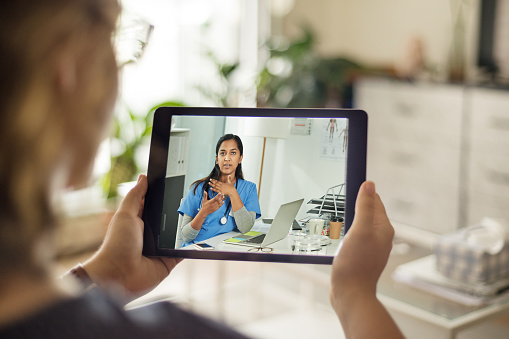Most people presume that all these measures to combat the biggest crisis of our generation will be temporary, and that at some point life will bounce back to its pre-coronavirus state and business will continue as usual. To some extent, this may be true - will go back to work and school and gather in restaurants and theatres and sports stadiums again. But many of these effects of these measures are likely to far outlast the current crisis.
Just like illness can lend itself to introspection, times of fundamental crisis also open up a window of opportunity for change and can fast-forward processes and decisions that in normal times could take years of planning and consideration. As there is not much in our recent experience to match the speed with which events have unfolded and in these unprecedented times, entire countries are serving as guinea-pigs in large-scale social experiments. What happens when health care systems are overwhelmed with more patients than they can feasibly treat? What happens when everybody works from home and communicates from a distance?
THE FUTURE OF HEALTHCARE
We haven't faced a public health emergency of this scale in a century and it is exposing the exclusion of certain groups from accessing care, the under-investment in free public healthcare for all, the failure of governments to plan for and deliver services that meet the needs of everyone, and our collective vulnerability. It is likely that people across the globe will use COVID-19 as a strong justification to demand properly funded, equitable and universal healthcare
Access to healthcare and the capacity of health systems is particularly a heightened concern at this time for those already living in poverty or experiencing income inequality, especially as the pandemic brings additional economic risks for low-income or less secure workers. In the US, the coronavirus is a stark reminder of the divide that exists between those who can afford healthcare and those who cannot and may be forced into extreme poverty as a result. People in the US must contend with a fragmented health system where just going to get tested can mean hundreds or thousands of dollars in medical bills -- a risk those in other developed countries don't face as it is the only developed nation without universal health care.
Nearly 28 million non-elderly Americans, or 10.4%, were uninsured in 2018, according to the most recent Census Bureau data available. 45,000 Americans are dying each year because they do not have health coverage. But even those who have insurance may not seek care that quickly, largely because they face hefty deductibles and out-of-pocket costs for doctor's visits, emergency room trips and treatment. Another weak point in the nation's fight against the coronavirus' spread is the lack of national standards on paid sick leave, a rarity among industrialised nations.
Journalists and healthcare experts have noted that countries like South Korea, which has a comprehensive form of national health care, has performed well in responding to the coronavirus outbreak. "South Korea also has a universal health care system (though a different one from Italy) and has dealt with the pandemic better than anywhere else," remarked Adam Serwer, staff writer at The Atlantic.
This realisation can in turn pressure the US leadership, and others around the world, to implement the necessary reforms to ensure all citizens have social security, comprehensive labour rights and access to adequate healthcare. With more than two-thirds of Americans, 67 percent, saying they are concerned about someone in their family becoming infected with the COVID-19 illness, a significant percentage of U.S. adults say they have newfound support for a federal government-backed health insurance plan. A new Morning Consult survey revealed that 26 percent of U.S. adults are now "much more likely" to support universal health care proposals.

Something else we’ve been hearing a lot about during the coronavirus crisis is “telehealth”. Telehealth includes all the health-related services that can be performed via digital technology and allow long-distance care, advice, and monitoring.
It’s easy to see why telehealth has become essential during coronavirus. As hospitals and public officials urge patients with symptoms of Covid-19 to avoid emergency rooms, online-only services that allow patients to consult with doctors over the phone, video, or direct message are a natural fit. Beyond individual-level care, the data gathered by telemedicine services can be mined to predict the broader ebb and flow of an epidemic’s trajectory in a population.
In Singapore, more than a million people have used a popular telehealth app called -MaNaDr, founded by family physician Dr. Siaw Tung Yeng, for virtual visits; 20% of the physicians in the island country offer some level of service via the app. In an effort to control escalating cases of coronavirus there, people with symptoms are getting prescreened by physicians on MaNaDr and advised to stay home if they don’t need intensive care. Patients then check in with their telehealth doctor every evening and report if their fever persists, if they have shortness of breath or if they are feeling worse. If they are getting sicker, the doctor orders an ambulance to take those people to the hospital
In the US, a third of the population already use telemedicine, and now, people currently have no other choice but to rely on it. The more they use it, the more they will learn to trust the method, allowing for the delivery of faster and cheaper healthcare. The Trump administration has used the president's national emergency declaration and an emergency funding package to lift key barriers to virtual care, including rules that limited payments for telehealth visits and blocked the use of popular video messaging platforms like FaceTime over privacy concerns. Many private insurers appear to be quickly following suit, raising the prospect that remote consultation could become the new normal long after the crisis subsides.
THE FUTURE OF WORK
Millions of office workers these days are swapping suits for sweatpants as the coronavirus has made working from home a sudden reality. Although working from home has been on the rise for a while- Gallup’s State of the American Workplace 2017 study found that 43% of employees work remotely with some frequency - not everyone has been eager to embrace the possibilities modern technology offers. In Germany, for example, around one in four companies let at least some of their employees work remotely, according to a study by the IAB Institute for Employment Research. Only twenty percent of workers made use of that. And the majority of those who didn't work from home said they actually wanted to go into the office every day. But, currently, many of them can't as Germany - along with many other countries hit by the coronavirus – are in the middle of a large-scale work from home experiment.
With the expectation that sustained efforts will be needed to deal with the pandemic, companies are preparing for months without their staff in offices. JPMorgan, AT&T, Google, Amazon, Nike, Facebook, among many, many more are moving quickly to virtualise and digitalise business operations as social distancing continues to be the best practice to “flatten the curve” of contagion.
Organisations have also been forced to invest in technology and to modify formal processes in order to manage a remote workforce. Companies not used to a remote work environment, but homebound now, are struggling with corporate servers and tools that don’t have the capacity for efficient group sharing. Organisations are also being forced to radically cut down or stop business travel, and realise that it’s not so essential after all.
With meetings being cancelled or shifted to video conferencing, according to Kentik, a global provider of network analytics, video conferencing traffic in North America and Asia has doubled since the outbreak began. At the Association for the Advancement of Artificial Intelligence conference in New York in early February, Chinese researchers mostly delivered their talks via video conferencing or canned presentations due to travel bans. The AAAI conference was lucky in that it was able to convene. Many are now wondering whether video conferences are the future and experts believe business leaders will come to see that central offices and face-to-face meetings are less vital than they thought. “This is unprecedented,” Ann Francke, head of the Chartered Management Institute told the Financial Times. “It may change the workplace forever. Everyone will need to embrace a different sort of workplace behaviour.”
While some see an upside to home working, admitting that coronavirus was pushing technophobe colleagues to embrace more digital working, the shift has not been without problems, as bankers worry about how they will be able to meet their clients and managers fret about how they keep staff motivated and productive at home. Plus, this arrangement is only realistic for white-collar workers as sending staff home is not an option for many occupations, including the entertainment workers, technicians, artisans, craftspersons and factory workers.
The COVID-19 pandemic is also resurfacing concerns about technology’s impact on the future of work. Experts are predicting that a coronavirus-related recession is likely to bring about a spike in labour-replacing automation. Automation tends to accelerate in bad times such as in the wake of economic shocks, when humans become relatively more expensive as firms’ revenues rapidly decline. At these moments, employers shed less-skilled workers and replace them with technology and higher-skilled workers, which increases labour productivity as a recession tapers off. The automation surge is likely to affect the most “routine” occupations—jobs in areas such as production, construction, food service, and transportation, for example. According to a report by The Brookings Institute, any downturn is likely to bring a new bout of structural change in the labor market and its demand for skills. “If it extends for a while, the downturn could induce firms in food service, retail, and administrative work to restructure their operations toward greater use of technology and higher-skilled workers. For America’s beleaguered lower-skill workers, these changes will complicate the return to normalcy,” the report said.
In other fields, the change will be equally dramatic and possibly for good. For example, higher education has been slow in moving into the online teaching space, but now that the sector is forced to deliver modules online, universities are unlikely to totally revert back to the previous status quo. There are huge opportunities offered by online education – in terms of new markets for students and cheaper delivery thanks to economies of scale.









